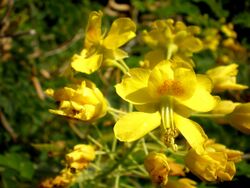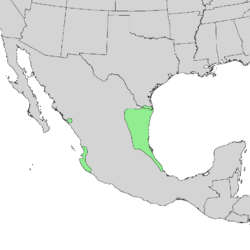Biology:Erythrostemon mexicanus
| Erythrostemon mexicanus | |
|---|---|

| |
| Scientific classification | |
| Kingdom: | Plantae
|
| (unranked): | |
| (unranked): | |
| (unranked): | |
| Order: | |
| Family: | |
| Genus: | |
| Species: | E. mexicanus
|
| Binomial name | |
| Erythrostemon mexicanus (A.Gray 1861) E. Gagnon & G. P. Lewis 2016
| |

| |
| Natural range | |
| Synonyms[1] | |
| |
Erythrostemon mexicanus, formerly Caesalpinia mexicana,[2] is a species of plant in the genus Erythrostemon, within the pea family, Fabaceae. Common names include Mexican holdback,[3] Mexican caesalpinia, and tabachín del monte.[4] It is native to the extreme lower Rio Grande Valley of Texas [5] and to parts of Mexico: in the northeast and further south along the Gulf coast as well as the Pacific coast in Nayarit, Jalisco, Colima, and a small portion of Sinaloa.[6]
Description
Mexican holdback is a small evergreen tree or large shrub, reaching a height of 3–4.6 m (9.8–15.1 ft) and a spread of 1.8–3 m (5.9–9.8 ft). Leaves are bipinnately-compound and dark green.[7] Each leaf has five to nine pinnae 4–9 cm (1.6–3.5 in) in length.[8] Pinnae are composed of four to five leaflets[7] that are 1–2.5 cm (0.39–0.98 in) long and 0.7–1.3 cm (0.28–0.51 in) wide.[8] Yellow, slightly fragrant flowers are produced on 7.6–15.2 cm (3.0–6.0 in) terminal spikes[7] of 10 to 30.[4] Blooming takes place from February to July, often continuing to October. The fruit is a dehiscent tan or yellow seedpod 5.1–7.6 cm (2.0–3.0 in) in length.[7]
Uses
Mexican holdback is cultivated as an ornamental because of its showy flowers, lush,[4] fine-textured foliage, and drought tolerance.[9]
Ecology
Erythrostemon mexicanus is the host plant for the caterpillars of the curve-winged metalmark (Emesis emesia).[10]
References
- ↑ "Caesalpinia mexicana A. Gray". TROPICOS. Missouri Botanical Garden. http://www.tropicos.org/Name/13003261. Retrieved 2009-11-25.
- ↑ "Erythrostemon mexicanus (Rose) Gagnon & G.P.Lewis" (in en). Royal Botanic Gardens, Kew. http://www.plantsoftheworldonline.org/taxon/60473357-2.
- ↑ "Caesalpinia mexicana A. Gray Mexican holdback". PLANTS Database. United States Department of Agriculture. http://plants.usda.gov/java/profile?symbol=CAME. Retrieved 2009-12-03.
- ↑ Jump up to: 4.0 4.1 4.2 Nokes, Jill (2001). How to Grow Native Plants of Texas and the Southwest (2 ed.). University of Texas Press. pp. 151–152. ISBN 978-0-292-75573-4. https://books.google.com/books?id=r9qqlxIOKTwC&dq.
- ↑ "Mexican Caesalpinia, Mexican Poinciana". Benny Simpson's Texas Native Trees. Texas A&M University. http://aggie-horticulture.tamu.edu/ornamentals/natives/caesalpiniamexicana.htm. Retrieved 2009-01-28.
- ↑ Little Jr., Elbert L. (1976). Atlas of United States Trees. 3 (Minor Western Hardwoods). US Government Printing Office. OCLC 4053799.
- ↑ Jump up to: 7.0 7.1 7.2 7.3 Irish, Mary (2008). Trees and Shrubs for the Southwest: Woody Plants for Arid Gardens. Timber Press. pp. 141–142. ISBN 978-0-88192-905-8. https://books.google.com/books?id=AyWkIsLDca8C&dq.
- ↑ Jump up to: 8.0 8.1 Richardson, Alfred (1995). Plants of the Rio Grande Delta. University of Texas Press. pp. 103–104. ISBN 978-0-292-77070-6. https://books.google.com/books?id=vF_1X65cDxYC.
- ↑ Gilman, Edward F (October 1999). "Caesalpinia mexicana Mexican Caesalpinia" (PDF). IFAS Extension. University of Florida. http://edis.ifas.ufl.edu/pdffiles/FP/FP08200.pdf. Retrieved 2010-11-23.
- ↑ "Curve-winged Metalmark Emesis emesia (Hewitson, 1867)". Butterflies and Moths of North America. http://www.butterfliesandmoths.org/species?l=1649. Retrieved 2009-11-29.
External links
- "Caesalpinia mexicana Mexican bird of paradise". Arid Plant List. University of Arizona. 2006-03-16. http://ag.arizona.edu/pima/gardening/aridplants/Caesalpinia_mexicana.html.
Wikidata ☰ Q42672348 entry Wikidata ☰ Q5016950 entry
 |

